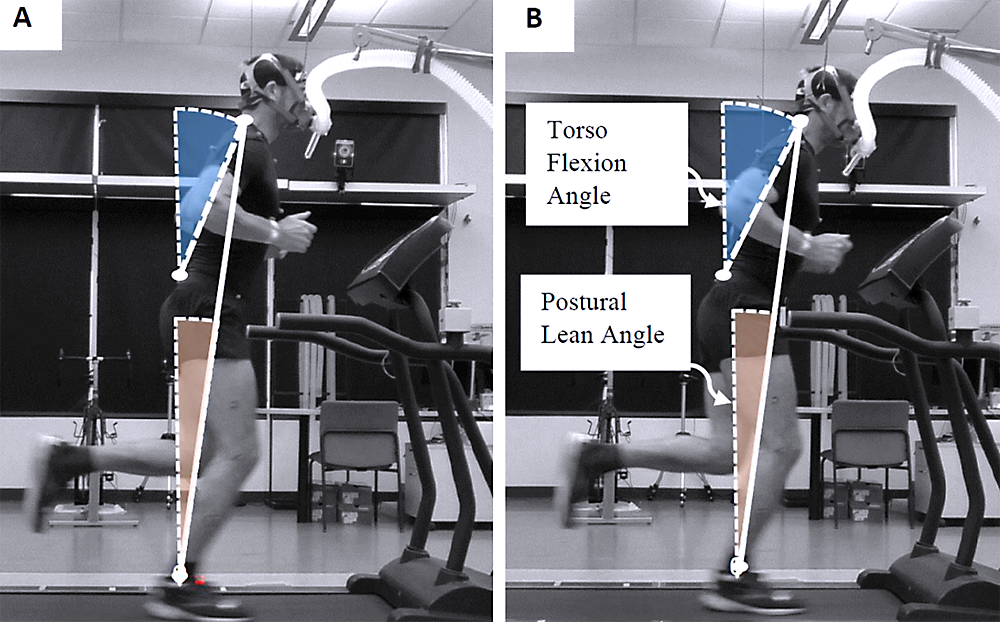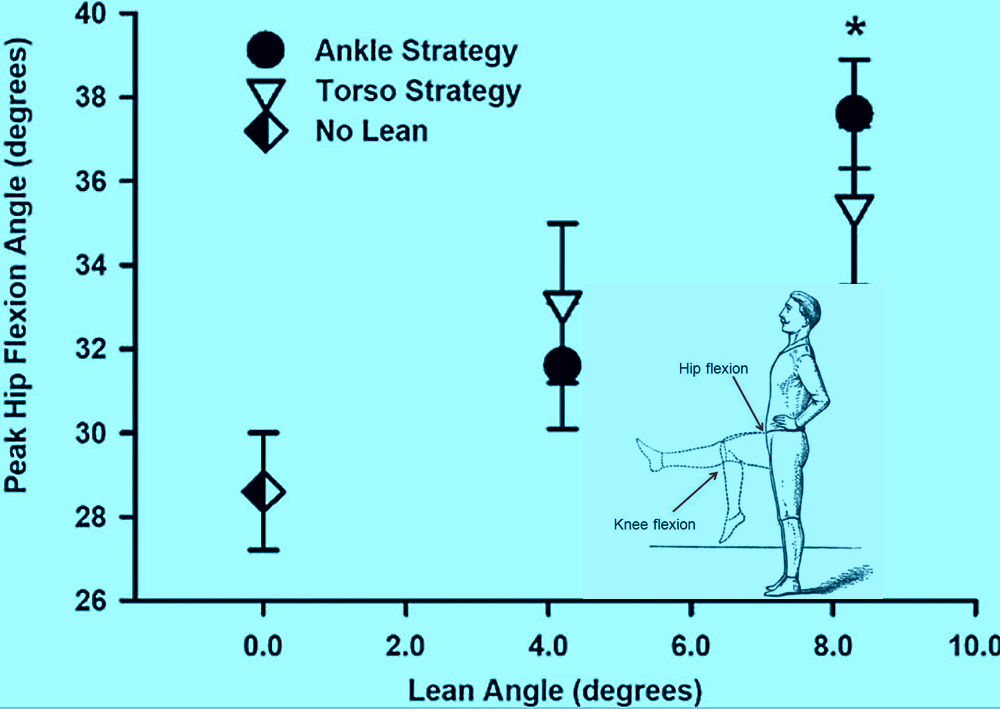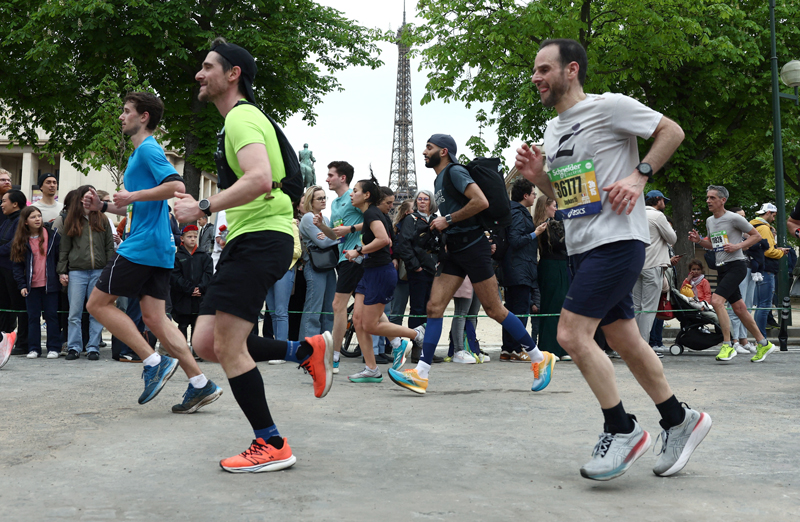You are viewing 1 of your 1 free articles. For unlimited access take a risk-free trial
Running efficiency: why posture matters for performance
SPB looks at new research on how a forward leaning posture while running can seriously affect performance
To improve running performance, many runners and coaches seek out ways to optimize running technique. However, some modifications to running technique are not always backed by scientific evidence. One popular theory is that running with a forward lean can improve running efficiency (more technically referred to as ‘running economy’), thereby improving performance(1). In short, running economy is a measure of how much oxygen is required to maintain a steady-state submaximal pace; research shows that better levels of running economy (ie lower oxygen consumption for a given pace) is highly predictive of running performance in distance events(2-4). [See this article for a more in-depth discussion of muscle economy in endurance sport.]
Running posture and efficiency
Could changing your running posture by running with a more forward lean really improve your running economy and therefore performance? The evidence regarding the effect of forward lean on running economy and muscle activation is far from straightforward. One early study found that optimal running economy was observed when runners ran using an average forward lean (trunk flexion) angle of 5.9 degrees, as opposed to more upright postures(5). However, this study did not actually test running economy changes with forward lean while running, but instead examined the natural trunk lean in runners classified from good to poor economy.
Furthermore, there have been no studies to date that have looked at the relationship between a deliberate forward lean while running and muscle activation patterns. This matters because leaning forward more generally has been shown to increase extensor muscle activation, increasing the loading on the lower back muscles (erector spinae) and the gluteal muscles of the buttocks(6,7). More muscle activation means more muscle work, greater energy expenditure and poorer muscle economy. On the flip side however, running with a forward leaning posture is known to reduce the forces experienced by the quadriceps of the frontal thigh by as much as 22%(8). In theory, this could not only could improve running economy, but is also known to help reduce stresses at the knee joint(9).
A further complication comes from the fact that the overall forward lean in posture when running can arise from two different components: trunk lean and ankle lean (see figure 1). In trunk forward leaning, the forward flexion occurs primarily at the hips but the overall forward lean is also determined by the degree of forward ankle lean. This refers to the angle away from vertical occurring at the ankle joint (imagine standing upright with a straight body while leaning forward slightly from the ankles). To date, there’s no data on how each type of forward lean might affect muscle activation and therefore running economy.
Figure 1: Forward leaning from the ankle and the torso

New research on running and forward lean
A popular theory or belief that a forward lean while running helps to improve running performance is all well and good, but is worth nothing unless it is scientifically validated in a properly conducted study. The good news is that newly published research by a team of US scientists from California has just been published, answering the questions above(10). In this study, which was published in the journal ‘Plos One’, the research team investigated the effects of postural lean (the amount of ankle and trunk lean plus the total forward body lean angle) on running economy, kinematics (limb movement patterns, and muscle activation.
Sixteen healthy young adult runners (eight women and eight men, average age of 23) were recruited for the study. To qualify, the participants had to:
· Be runners who trained either for fitness or competition.
· Have a PB time for 5km of 22 minutes or less.
· Be free of any neurological or orthopedic disorders (which could affect running economy) in the six months prior to participation.
Each of the participants completed an experimental session of running on a motorized treadmill at a steady 8mph. This session consisted of six parts. The first was a 5-minute initial familiarization trial, where the runners ran in an upright posture on the level, with the goal of getting used to the treadmill. There then followed five more trials, all run at 8mph on the level:
· Five minutes running in an upright (minimal lean) posture.
· Five minutes with a moderate postural lean from the ankle.
· Five minutes with a maximal postural lean from the ankle.
· Five minutes with a moderate postural lean from the torso.
· Five minutes with a maximal postural lean from the torso.
In order to help minimize any ‘trial order effect’ (eg fatigue from earlier trials affecting the later trials), the runners performed these five trials in a randomized counterbalanced trial order. In the ankle strategy trials, subjects were instructed to “lean forward from the ankle” and for the torso strategy trials, subjects were instructed to “lean from the hip”. During the trials, the runners were live videoed and could see their posture projected onto a large screen, thus providing them with visual feedback and helping them to adjust their posture if necessary. They also received verbal feedback where needed. For example, in the upright trial, participants were instructed to “run as upright as possible minimizing the lean forward”. For the maximal forward lean trials, participants were instructed to “run with as far forward of a lean as you can while leaning from the ankle”. The research staff would also sometimes need to remind participants to “try your best to match the prescribed lean angle on the video monitor”.
During the five trials, the runners recorded data from the runners including total postural lean angle and torso flexion angle (degrees) as well as ‘net metabolic power’ (measured in watts per kilo of bodyweight). Note that for any given running speed, lower metabolic power indicates less oxygen needed to sustain that speed, which equates to better running economy. In addition, various kinematic measures were recorded such as ground contact time (milliseconds), stride length, peak hip flexion (degrees) and peak knee flexion (degrees). In addition, muscle activation data was collected via electrodes placed on the skin
What they found
Did the trials in which the runners used a forward leaning posture result in better running economy as is commonly believed? Not at all – in fact the exact opposite effect was observed. Compared with an upright running posture, during which the runners ran with very minimal forward lean (just 1.8 degrees), a moderate forward lean angle of around 4.2 degrees resulted in a 2% decline in running economy (see figure 2). In other words, at that 8mph steady-state pace, the runners consumed 2% more oxygen and expended 2% more energy. This might not sound a lot but over a long distance, the extra energy expenditure would certainly have a negative impact on performance.
When the runners ran with a large amount of postural forward lean (8.4%), running economy declined by a further (and whopping) 6%, resulting in a huge drop of 8% in running economy compared to an upright posture (figure 2). Moreover, when the researchers dug into the data a little more, they found a simple linear relation between forward lean and running economy; the runners who run with the highest amounts of forward lean invariably had the poorest levels of running economy.
The third key finding was that it didn’t seem to matter whether the forward lean angle during running was as a result of ankle lean or torso lean – the overall decline in running economy that occurred was due to total forward lean regardless of where that forward lean emanated from. Finally, an examination of kinematic data revealed that greater forward lean angles consistently increased maximum knee and hip flexion during running (see figure 3) – ie the relative to the torso, the runners lifted their thighs higher and had more leg bend at the knee joint. Again, these kinematic findings were the same regardless of where the forward lean emanated from (ankle or torso).
Figure 2: Forward lean angle and running economy
Black dots = forward leaning from ankles; triangles = forward leaning from torso. Vertical axis shows watts per kilo required at 8mph (lower values indicate better running economy). Forward leaning resulted in significantly poorer running economy, and the more forward lean, the poorer the economy that resulted – regardless of where that lean emanated from.
Figure 2: Forward lean angle and hip flexion

Practical implications for athletes
Unlike some research studies, the findings from this study on posture and forward lean while running were pretty unequivocal; compared to an upright posture with minimal lean, a forward lean results in reduced running economy – a very undesirable finding given the importance of running economy in overall distance running performance. At the very least therefore, we can conclude that the notion of running with a forward leaning posture to enhance economy and performance is false. Whilst it is true that a forward lean can help reduce impact forces at the knee joint(8) - and so may be a useful temporary strategy following a knee injury – it is definitely not recommended for most runners most of the time.
However, there is another take-home message here, which is related to muscle movement patterns. The forward leaning posture during running was highly correlated with peak hip flexion and knee flexion. However, this relationship is a two-way one; while a forward leaning posture entails more hip and knee flexion, we can be pretty certain that where runners have a tendency to more hip and knee flexion, they will likely compensate by leaning forwards more.
For any given stride length, a runner will display certain range of hip movement. If there are high levels of hip flexion, it’s likely that the runner will not be extending his or her hip as efficiently as they should. NB: hip extension during running occurs when the trailing leg is fully lengthened behind the runner and about to push off for the next stride. There are two reasons why this can occur:
· Hip flexor muscle tightness – these muscles are lengthened during hip extension so if there is residual tightness and/or shortening, it becomes harder to extend the hip through its full range of motion.
· Gluteal weakness – the gluteal muscles of the buttocks are the main driving force for hip extensions. Therefore, weak gluteal muscles (very common) can reduce make it harder for runners to achieve a full range of hip extension motion, and may result in a slight forward lean to help compensate for this weakness.
The same arguments can be made when a runner unconsciously leans forward from the ankles. This may occur to help compensate for weaker and calf muscles than are desirable, which results in less driving force at the foot during push off, in turn necessitating a slightly forward lean to compensate.
If you’re a runner, how can you use this information? The first thing is to check your own running posture, perhaps by getting a friend or family member to video you when running on the flat (eg a treadmill) from a sideways-on angle. If you compare your running posture to other runners (especially runners performing at a high level who invariably hold a nice upright posture running) and you are aware that your posture tends to involve leaning forward noticeably, you might want to consider some stretches for the hip flexor muscles along with some gluteal and calf strengthening work. These could help you achieve a more upright running posture by correcting muscle strength and tension imbalances.
For an excellent short video on hip flexor tightness assessment and stretching, this presentation is an excellent place to start.
Meanwhile, this video provides some great strengthening exercises for the glutes (and hamstrings, which are often co-activated).
Finally, for tips on calf strengthening, this E3 rehab video
is very informative.
References
1. Sports Biomech. 2007. Sep 1;6(3):434–52
2. J Strength Cond Res. 2010 Aug;24(8):2157-65
3. J Physiol. 2008 Jan 1; 586(1):35-44
4. Appl Physiol Nutr Metab. 2006 Oct;31(5):530-40
5. J App Physiol. 1987. Sep;63(3):1236–45
6. Proc R Soc B: Biol Sci. 2022. Oct 26;289(1985):20221189
7. J Hum Evol. 2013. Sep 1;65(3):294–302
8. J Orthop Sports Phys Ther. 2014. Oct;44(10):785–92
9. Hum Mov Sci. 2021. Aug 1;78:102817
10. PLoS One. 2024; 19(5): e0302249
Newsletter Sign Up
Testimonials
Dr. Alexandra Fandetti-Robin, Back & Body Chiropractic
Elspeth Cowell MSCh DpodM SRCh HCPC reg
William Hunter, Nuffield Health
Newsletter Sign Up
Coaches Testimonials
Dr. Alexandra Fandetti-Robin, Back & Body Chiropractic
Elspeth Cowell MSCh DpodM SRCh HCPC reg
William Hunter, Nuffield Health
Keep up with latest sports science research and apply it to maximize performance
Today you have the chance to join a group of athletes, and sports coaches/trainers who all have something special in common...
They use the latest research to improve performance for themselves and their clients - both athletes and sports teams - with help from global specialists in the fields of sports science, sports medicine and sports psychology.
They do this by reading Sports Performance Bulletin, an easy-to-digest but serious-minded journal dedicated to high performance sports. SPB offers a wealth of information and insight into the latest research, in an easily-accessible and understood format, along with a wealth of practical recommendations.
*includes 3 coaching manuals
Get Inspired
All the latest techniques and approaches
Sports Performance Bulletin helps dedicated endurance athletes improve their performance. Sense-checking the latest sports science research, and sourcing evidence and case studies to support findings, Sports Performance Bulletin turns proven insights into easily digestible practical advice. Supporting athletes, coaches and professionals who wish to ensure their guidance and programmes are kept right up to date and based on credible science.











